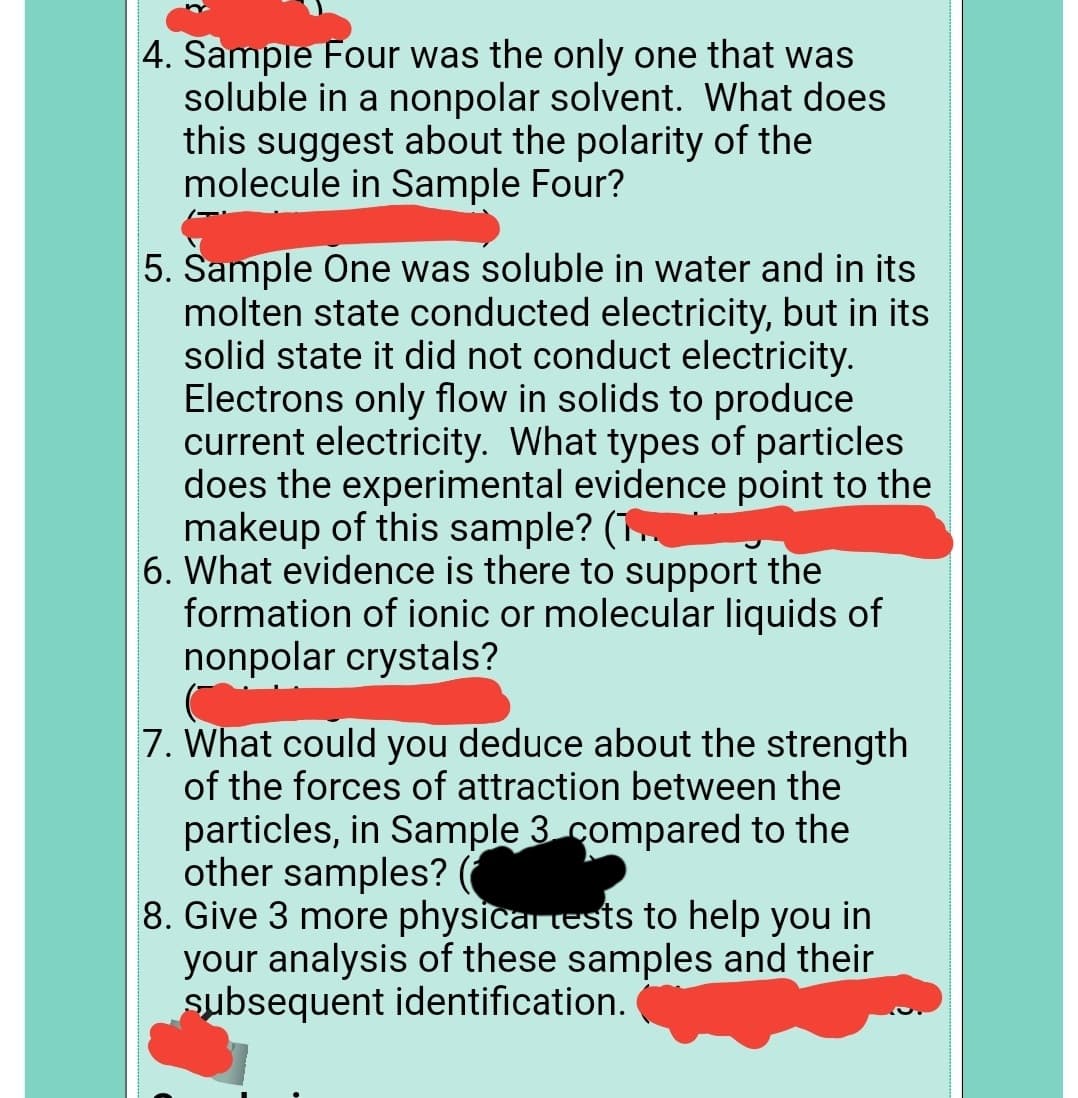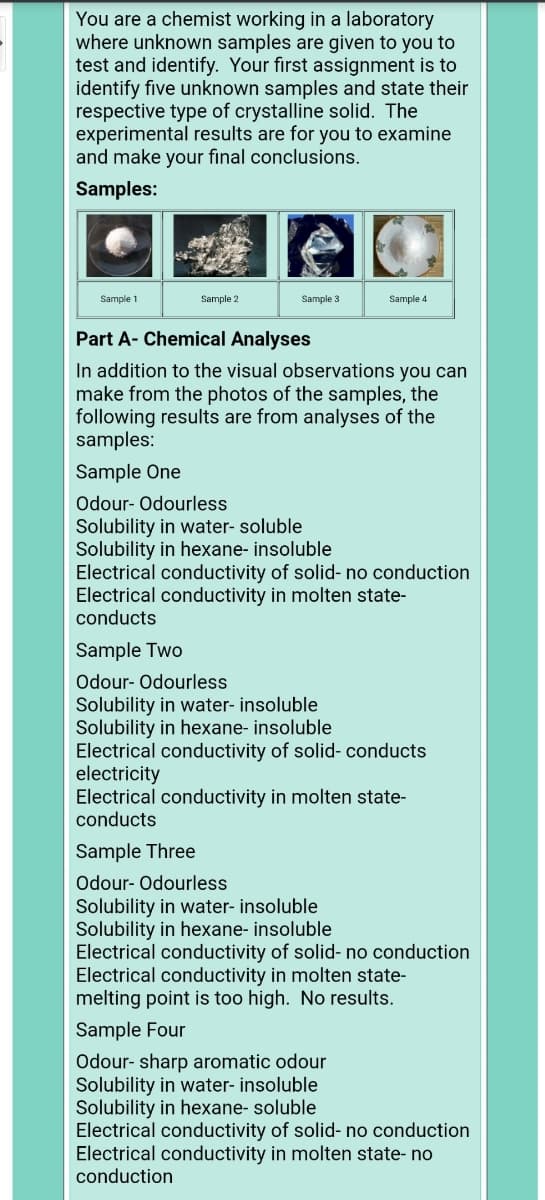. Sample Four was the only one that was soluble in a nonpolar solvent. What does this suggest about the polarity of the molecule in Sample Four? . Sample One was soluble in water and in its molten state conducted electricity, but in its solid state it did not conduct electricity. Electrons only flow in solids to produce current electricity. What types of particles does the experimental evidence point to the makeup of this sample? ( What evidence is there to support the formation of ionic or molecular liquids of nonpolar crystals?
. Sample Four was the only one that was soluble in a nonpolar solvent. What does this suggest about the polarity of the molecule in Sample Four? . Sample One was soluble in water and in its molten state conducted electricity, but in its solid state it did not conduct electricity. Electrons only flow in solids to produce current electricity. What types of particles does the experimental evidence point to the makeup of this sample? ( What evidence is there to support the formation of ionic or molecular liquids of nonpolar crystals?
Chemistry by OpenStax (2015-05-04)
1st Edition
ISBN:9781938168390
Author:Klaus Theopold, Richard H Langley, Paul Flowers, William R. Robinson, Mark Blaser
Publisher:Klaus Theopold, Richard H Langley, Paul Flowers, William R. Robinson, Mark Blaser
Chapter10: Liquids And Solids
Section: Chapter Questions
Problem 63E: Elemental carbon has one gas phase, one liquid phase, and two different solid phases, as shown in...
Related questions
Question
100%
From part a : answer the question 4-8

Transcribed Image Text:4. Sample Four was the only one that was
soluble in a nonpolar solvent. What does
this suggest about the polarity of the
molecule in Sample Four?
5. Sample One was soluble in water and in its
molten state conducted electricity, but in its
solid state it did not conduct electricity.
Electrons only flow in solids to produce
current electricity. What types of particles
does the experimental evidence point to the
makeup of this sample? (.
6. What evidence is there to support the
formation of ionic or molecular liquids of
nonpolar crystals?
7. What could you deduce about the strength
of the forces of attraction between the
particles, in Sample 3 compared to the
other samples? (
8. Give 3 more physicar tests to help you in
your analysis of these samples and their
subsequent identification.

Transcribed Image Text:You are a chemist working in a laboratory
where unknown samples are given to you to
test and identify. Your first assignment is to
identify five unknown samples and state their
respective type of crystalline solid. The
experimental results are for you to examine
and make your final conclusions.
Samples:
Sample 1
Sample 2
Sample 3
Sample 4
Part A- Chemical Analyses
In addition to the visual observations you can
make from the photos of the samples, the
following results are from analyses of the
samples:
Sample One
Odour- Odourless
Solubility in water- soluble
Solubility in hexane- insoluble
Electrical conductivity of solid- no conduction
Electrical conductivity in molten state-
conducts
Sample Two
Odour- Odourless
Solubility in water- insoluble
Solubility in hexane- insoluble
Electrical conductivity of solid- conducts
electricity
Electrical conductivity in molten state-
conducts
Sample Three
Odour- Odourless
Solubility in water- insoluble
Solubility in hexane- insoluble
Electrical conductivity of solid- no conduction
Electrical conductivity in molten state-
melting point is too high. No results.
Sample Four
Odour- sharp aromatic odour
Solubility in water- insoluble
Solubility in hexane- soluble
Electrical conductivity of solid- no conduction
Electrical conductivity in molten state- no
conduction
Expert Solution
This question has been solved!
Explore an expertly crafted, step-by-step solution for a thorough understanding of key concepts.
Step by step
Solved in 2 steps

Knowledge Booster
Learn more about
Need a deep-dive on the concept behind this application? Look no further. Learn more about this topic, chemistry and related others by exploring similar questions and additional content below.Recommended textbooks for you

Chemistry by OpenStax (2015-05-04)
Chemistry
ISBN:
9781938168390
Author:
Klaus Theopold, Richard H Langley, Paul Flowers, William R. Robinson, Mark Blaser
Publisher:
OpenStax

Introductory Chemistry: A Foundation
Chemistry
ISBN:
9781337399425
Author:
Steven S. Zumdahl, Donald J. DeCoste
Publisher:
Cengage Learning

Chemistry: Principles and Reactions
Chemistry
ISBN:
9781305079373
Author:
William L. Masterton, Cecile N. Hurley
Publisher:
Cengage Learning

Chemistry by OpenStax (2015-05-04)
Chemistry
ISBN:
9781938168390
Author:
Klaus Theopold, Richard H Langley, Paul Flowers, William R. Robinson, Mark Blaser
Publisher:
OpenStax

Introductory Chemistry: A Foundation
Chemistry
ISBN:
9781337399425
Author:
Steven S. Zumdahl, Donald J. DeCoste
Publisher:
Cengage Learning

Chemistry: Principles and Reactions
Chemistry
ISBN:
9781305079373
Author:
William L. Masterton, Cecile N. Hurley
Publisher:
Cengage Learning

Introductory Chemistry: An Active Learning Approa…
Chemistry
ISBN:
9781305079250
Author:
Mark S. Cracolice, Ed Peters
Publisher:
Cengage Learning

Chemistry: Matter and Change
Chemistry
ISBN:
9780078746376
Author:
Dinah Zike, Laurel Dingrando, Nicholas Hainen, Cheryl Wistrom
Publisher:
Glencoe/McGraw-Hill School Pub Co

Principles of Modern Chemistry
Chemistry
ISBN:
9781305079113
Author:
David W. Oxtoby, H. Pat Gillis, Laurie J. Butler
Publisher:
Cengage Learning